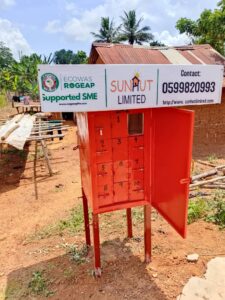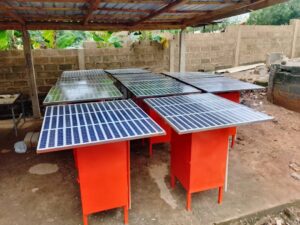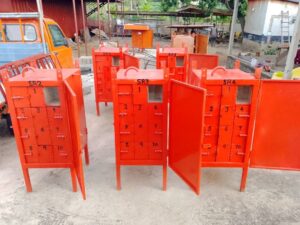Sunhut Limited - Solar Kiosk- ROGEAP
The project seeks to join the numerous efforts to address the problem of lack of access to electricity in remote areas by providing within a two year period, 3000 solar lanterns for rental and 1000 solar lanterns and panels for sale, through 200 self-charging solar kiosks which will as well as provide electricity to meet the minimum electricity needs of off grid remote communities for the operation of needed appliances such as phones and radios.
A kiosk has 10 lockable charging compartments, 160watt solar system, and capacity to charge 20 lamps and phones per day. Customers without the means to invest upfront in a solar system or who are not sufficiently convinced of investing in a solar system pay an average weekly fee to rent the charging compartment with 2 charging cables and 1 solar lamp in order to experience the benefits. After sufficient time, they save money from not using expensive alternatives in order to acquire components of the solar home system when they so decide.
Target Market & Beneficiaries:
The Low income off -grid communities in Afram plains, Gambaga and its environs, Adawso and its environs and Duakwa and its environs, benefiting 4000 households, with an estimated 12000 people having access to electrical energy.
Sunhut Solar (PV) Systems & Lanterns for Remote Homes
About Program
The little evidence available indicates that the poor are often the last to benefit from increased access to energy. "In most countries, the rural poor tend to be overlooked because private operators are reluctant to serve low-income clients given that these markets are not financially viable on a freestanding basis.”(World Bank 2003)
Deploying solar PV (Photo Voltaic) and lantern services for remote communities, addresses the use of off grid electricity to enhance the social and economic development of the community. This can be achieved by developing partnerships with appropriate regional and national organizations, manufacturers plus funding agencies, and carrying out work on specific applications of interest and relevant business models.
Photovoltaics, and other renewable energy technologies, can significantly contribute to economic and social development of communities especially those far from the reach of grid electricity. About 1.5 billion people worldwide, many of whom live in isolated areas, still do not have access to electricity or to clean water, primary health care, education and other basic services, all of which are largely dependent on access to electricity.
Tackling this issue is an essential for the economic and social development of any modern community. Sunhut Limited PV services is a project focused on bringing one of the essential use of electricity to our remote communities which is lighting and mobile phone charging.
Marketing model for PV systems
Considering the purchasing limitation of the rural poor, the following approaches have been adopted as basis for the programs we run in the various communities we operate in to ensure easy access to the product for customers of all income levels.
Cash: The consumer pays fully for the system and ownership is transferred to the consumer.
Credit: The consumer receives the system and pays regular installments plus possibly a down payment.
Leasing: The consumer is allowed to use the system and pays regular installments. Initially, the company owns the system. Later, once the system is fully paid for by the consumer, the ownership is transferred.
Fee-for-Service (Renting): The consumer is allowed to use the system that is owned by the company. The system is returned after period of service.



